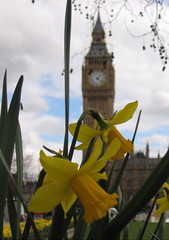Personal
Best Accomplishment: Getting my MSc. Despite doing all the work for it in 2005 and 2006, I officially got my masters degree this February. Not only was it nice to see the fulfillment of my work in Bristol, but I got to return to England for the graduation, a trip that in and of itself was one of the year's highlights. Honorary mention: SVP poster, acceptance into Analytical Paleobiology course, winning Thomas Condon award.
Best Port of Call During my Nomadic Summer: Santa Barbara. I could never afford to live there full-time (half a summer there pretty effectively bankrupted me), but there are few cities on Earth more lovely and better-located than Santa Barbara. Good wine, too. Honorable mention: Bay Area, John Day Country.
Biggest News Stories in...
Science: Public perception of science. The good news: the Bush administration finally (and apparently unwillingly) recognized that anthropogenic climate change is real and public opinion on the matter seems to have shifted in favor of action. The bad news: public understanding of science in the US remains abysmal, exemplified by the success of Kentucky's new (and very well funded) Creation Museum. Honorable mention: reprogramming of cells to behave as stem cells.
 Paleontology: Ice age meteorite. I may be biased because a researcher from the U of O was in on this study, but the notion of an extraterrestrial impact triggering the most recent ice age is an interesting one, and the evidence at hand seems to support it fairly well. Honorable mention: sequencing of DNA from Tyrannosaurus and a mastodon.
Paleontology: Ice age meteorite. I may be biased because a researcher from the U of O was in on this study, but the notion of an extraterrestrial impact triggering the most recent ice age is an interesting one, and the evidence at hand seems to support it fairly well. Honorable mention: sequencing of DNA from Tyrannosaurus and a mastodon.Sports: Fiesta Bowl. It happened all of one day into 2007, but people are still calling it the best football game ever played. I always enjoy a good David-over-Goliath type victory, and the game was made all the sweeter by the underdog (Boise State) being relatively local and the favorite (Oklahoma) being one of the most universally despised teams in college sports. Honorable mention: the Colorado Rockies' improbable World Series run.
In Memoriam
No recap of 2007 would be complete without acknowledging the loss of two of the greatest teachers I have ever had: Paul Raymond and Floyd Standifer. Paul was an advocate of social responsibility and civil disobedience who practiced what he preached, and he is the reason that I and several of my classmates traveled to El Salvador in 1999 to observe that country's national elections (an experience that taught me a great deal more about democracy than any US election ever could). Floyd was a Seattle jazz legend and will rightly be remembered as such, but he was also the leader of the Northwest School jazz ensemble, in which I played for seven years. I will forever be indebted to him for taking a chance on a scrawny young trombonist and subsequently teaching me most of what I know about music. It may be a little late now, but thanks to both of you.
It's had its ups and it's had its downs, but on the whole, my '007 was both productive and enjoyable. I hope yours were as well, and may your '008s be even better! Happy New Year!























